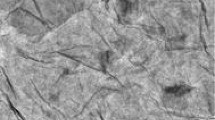Abstract
Herein, a urethane-based photo-polymeric network containing low content of amine-modified graphene sheets (GSs) was characterized. Scanning electron microscopy (SEM), wide-angle X-ray diffraction and Fourier transform infrared spectroscopy were used to investigate the morphological properties of the modified GSs. SEM, atomic force microscopy (AFM) and dynamical mechanical analysis techniques were also employed to study the physico-mechanical properties of the photo-polymeric network containing amine-functionalized GSs. We showed that amine groups attached to the GSs can lead to a new interfacial stress concentrator layer around GSs. This new interfacial layer formation was explained on the basis of the oxygen-scavenging effect of the amine groups. Also, by using AFM data the thickness of the high-modulus interfacial layer was estimated to be between 1 and 3 microns. Furthermore, the dynamic fragility index and the cooperatively rearranging (CRR) size corresponding to the highly cross-linked interfacial layer were found to be 74 and 6, respectively. The dynamic fragility index of the nano-gel particle was also obtained to be the lowest (37). Finally, it was shown that the incorporation of amine-modified GSs into the photo-polymeric network not only can offer higher dissipation factor but also increases the temperature corresponding to the maximum damping factor.






Reproduced with the permission from [15]






Similar content being viewed by others
References
Hu K, Kulkarni DD, Choi I, Tsukruk VV (2014) Graphene-polymer nanocomposites for structural and functional applications. Prog Polym Sci 39:1934–1972. https://doi.org/10.1016/j.progpolymsci.2014.03.001
Kuwahara RY, Oi T, Hashimoto K (2015) Easy preparation of graphene-based conducting polymer composite via organogel. Colloid Polym Sci 293:1635–1645. https://doi.org/10.1007/s00396-015-3539-2
Ramezanzadeh B, Ghasemi E, Mahdavian M (2015) Covalently-grafted graphene oxide nanosheets to improve barrier and corrosion protection properties of polyurethane coatings. Carbon 93:555–573. https://doi.org/10.1016/j.carbon.2015.05.094
Thomassin JM, Trifkovic M, Alkarmo W (2014) Poly(methyl methacrylate)/graphene oxide nanocomposites by a precipitation polymerization process and their dielectric and rheological characterization. Macromolecules 47:2149–2155. https://doi.org/10.1021/ma500164s
Zhang M, Li Y, Su Z, Wei G (2015) Recent advances in the synthesis and applications of graphene–polymer nanocomposites. Polym Chem 6:6107–6124. https://doi.org/10.1039/C5PY00777A
Kashi S, Gupta RK, Kao N, Bhattacharya SN (2016) Electrical, thermal, and viscoelastic properties of graphene nanoplatelet/poly(butylene adipate-co-terephthalate) biodegradable nanocomposites. J Appl Polym Sci 133:43620. https://doi.org/10.1002/app.43620
da Silva LCO, Soares BG (2017) Effects of graphene functionalization on the long-term behavior of epoxy/graphene composites evaluated by dynamic mechanical analysis. J Appl Polym Sci 134:44816. https://doi.org/10.1002/app.44816
Tang LC, Wan YJ, Yan D (2013) The effect of graphene dispersion on the mechanical properties of graphene/epoxy composites. Carbon 60:16–27. https://doi.org/10.1016/j.carbon.2013.03.050
Du X, Jiang G, Li L (2015) Photo-induced synthesis glucose-responsive carriers for controlled release of insulin in vitro. Colloid Polym Sci 293:2129–2135. https://doi.org/10.1007/s00396-015-3625-5
Yazdani-Ahmadabadi H, Rastegar S, Ranjbar Z (2016) Acidic hydrophobic nanosilica particle-induced mechanical dissipation and adhesion promotion of acrylate-based photopolymeric nanocoatings. Prog Org Coat 100:173–177. https://doi.org/10.1016/j.porgcoat.2016.05.004
Yazdani-Ahmadabadi H, Rastegar S, Ranjbar Z (2016) Slip-stick diffusion behavior caused by photo-polymerization-induced nano-gelation in highly heterogeneous photo-polymeric coatings. Prog Org Coat 97:184–193. https://doi.org/10.1016/j.porgcoat.2016.04.010
Habibpour S, Yazdani-Ahmadabadi H (2016) Study of cooperative relaxation characteristics of a simultaneously nanoparticle- and photopolymerization-Induced dynamically quaternary photopolymeric network. Polym Test 50:309–314. https://doi.org/10.1016/j.polymertesting.2015.12.009
Yazdani-Ahmadabadi H, Rastegar S, Ranjbar Z (2015) A modified De-Gennes’s trumpet model for the prediction of practical adhesion of dynamically- and structurally heterogeneous polymeric networks on solid surfaces. RSC Adv 5:49400–49407. https://doi.org/10.1039/C5RA05309A
Hodge IM (1996) Strong and fragile liquids—a brief critique. J Non Cryst Solids 202:164–172. https://doi.org/10.1016/0022-3093(96)00151-2
Yazdani-Ahmadabadi H, Rastegar S, Ranjbar Z (2015) Modeling physico-mechanical properties of an individual photopolymerization-induced urethane-based microgel particle. Polymer 74:124–132. https://doi.org/10.1016/j.polymer.2015.08.001
Yu B, Wang X, Xing W et al (2013) Enhanced thermal and mechanical properties of functionalized graphene/thiol-ene systems by photopolymerization technology. Chem Eng J 228:318–326. https://doi.org/10.1016/j.cej.2013.04.093
Martin-Gallego M, Verdejo R, Lopez-Manchado MA, Sangermano M (2011) Epoxy-graphene UV-cured nanocomposites. Polymer 52:4664–4669. https://doi.org/10.1016/j.polymer.2011.08.039
Blanton TN, Majumdar D (2012) X-ray diffraction characterization of polymer intercalated graphite oxide. Powder Diffr 27:104. https://doi.org/10.1017/s0885715612000292
Wang Y, Liao X, Luo Y (2015) Influence of surface-functionalized graphene oxide on the cell morphology of poly (methyl methacrylate) composite. J Mater Sci Technol 31:463–466. https://doi.org/10.1016/j.jmst.2015.01.010
Sow C, Riedl B, Blanchet P (2010) Kinetic studies of UV-waterborne nanocomposite formulations with nanoalumina and nanosilica. Prog Org Coatings 67:188–194. https://doi.org/10.1016/j.porgcoat.2009.10.002
Vogel H (1921) The law of the relationship between viscosity of liquids and the temperature. Phys Zeitschrift 22:645–646
Fulcher GS (1923) Analysis of recent measurements of the viscosity of glasses. J Am Ceram Soc 8:339–355
Tammann G, Hesse W, Anorg Z (1926) The dependence of viscosity upon the temperature of supercooled liquids. Allg Chem 156:245–247
Angell CA (1997) Why C-1 = 16–17 in the WLF equation is physical—and the fragility of polymers. Polymer 38:6261–6266. https://doi.org/10.1016/s0032-3861(97)00201-2
Qazvini NT, Mohammadi N (2005) Dynamic mechanical analysis of segmental relaxation in unsaturated polyester resin networks: effect of styrene content. Polymer 46:9088–9096. https://doi.org/10.1016/j.polymer.2005.06.118
Arkhipov VI, Baessler H (1994) Random-walk approach to dynamic and thermodynamic properties of supercooled melts. 1. Viscosity and average relaxation times in strong and fragile liquids. J Phys Chem 98:662–669. https://doi.org/10.1021/j100053a047
Korus J, Hempel E, Beiner M (1997) Temperature dependence of α glass transition cooperativity. Acta Polym 48:369–378. https://doi.org/10.1002/actp.1997.010480904
Tran TA, Saïd S, Grohens Y (2005) Nanoscale characteristic length at the glass transition in confined syndiotactic poly(methyl methacrylate). Macromolecules 38:3867–3871. https://doi.org/10.1021/ma0487296
Hong L, Novikov VN, Sokolov AP (2011) Is there a connection between fragility of glass forming systems and dynamic heterogeneity/cooperativity? J Non Cryst Solids 357:351–356. https://doi.org/10.1016/j.jnoncrysol.2010.06.071
Funding
This study has no sources of financial funding and support.
Author information
Authors and Affiliations
Corresponding authors
Ethics declarations
Conflict of interest
The authors declare that they have no conflict of interest.
Rights and permissions
About this article
Cite this article
Habibpour, S., Yazdani-Ahmadabadi, H. & Faramarzzi Jolfaei, A. Amine-functionalized graphene sheet-induced highly dissipative interfacial regions in photo-polymeric networks containing self-dispersed nano-gel particles. Polym. Bull. 75, 5843–5858 (2018). https://doi.org/10.1007/s00289-018-2364-4
Received:
Revised:
Accepted:
Published:
Issue Date:
DOI: https://doi.org/10.1007/s00289-018-2364-4




